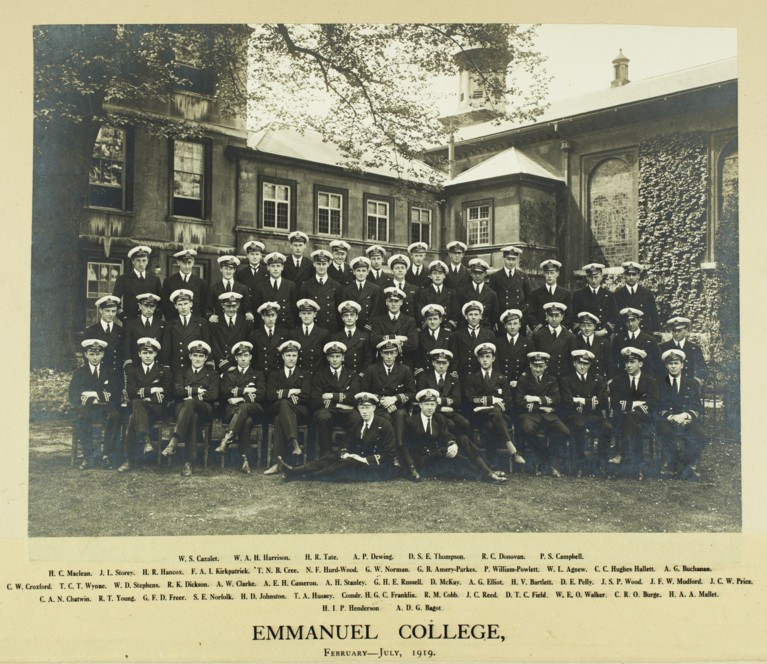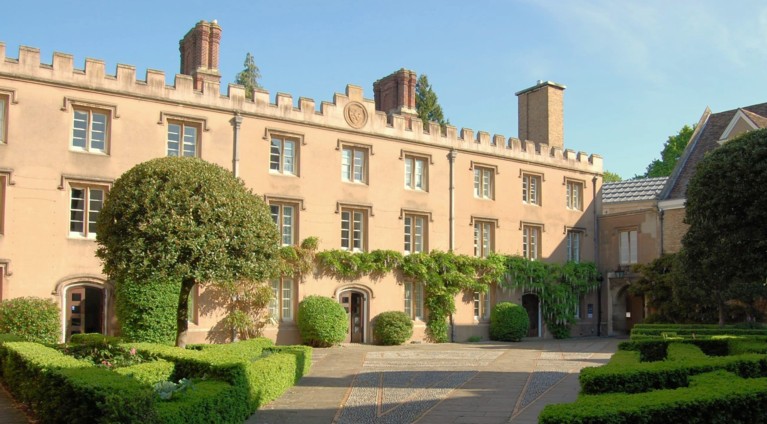Blog
28 May 2025
N is for … Naval Officers

The Royal Navy is an unlikely entity to be associated with a Cambridge college, but the answer lies in the First World War. Emmanuel’s North Court was occupied for the duration by successive groups of Army cadet officers following specially devised ‘Short Courses’, instruction being provided by University academics. A modified version of this scheme was extended to navy personnel after the war, and some fifty R.N. officers were billeted in North Court almost as soon as the army had left. The group’s official photo is inscribed ‘February-July 1919’, but their Commander, Harold Gordon Cooper Franklin (later Rear-Admiral), had already arrived. The Parlour officially welcomed him on 9 January and toasted his birthday six days later. One of Franklin’s navy reports described him as ‘good-looking, of fine physique and a magnificent presence. A very nice fellow though noisy in speech’. A lively addition to the Parlour, then! During their six-month residence at Emmanuel, the naval officers participated enthusiastically in college tennis and cricket matches, but it was as members of the boat club that they really left their mark. In the May Week fixed-seat races, they clobbered the opposition, employing aggressive oarsmanship in a boat dubbed the ‘Drunkards’ Express’. While the R.N. officers hugely enjoyed their time at Emmanuel, as had the cadets before them, there is no doubt that the college authorities were keen to get the place back to normal. A passage in the first post-war college Magazine describes, perhaps not entirely humorously, how the new undergraduates had ‘entered upon the task of bearing up against the invasions of demobilised soldiers, Naval Officers and American [army] visitors’. It was not until Easter Term 1922, however, that Emmanuel said goodbye to its final batch of R.N. officers.
N is for … New Court

Few members, perhaps, when traversing the cobbles of New Court, have queried the rationale behind the courtyard’s name, yet there are good reasons for doing so. For one thing, far from being new, two sides of the court (the Hall and the Old Library) feature the oldest surviving college buildings, and a third range (the Kitchen) retains its Elizabethan façade. Confusion can also arise from the fact that ‘New Court’ refers not only to the whole courtyard, but also, specifically, to the building forming its north side. This neo-Tudor range, designed by flamboyant Cambridge architect Charles Humfrey, was erected in 1824, and it might reasonably be supposed that the name ‘New Court’ was bestowed at that time. In fact, the term was not coined until the late nineteenth century, when the rapid expansion of the college necessitated fixed nomenclature being assigned to both its buildings and individual staircases. Before then, any new structure put up at Emmanuel was generally known as ‘the new building(s)’ until a successor came along, and Humfrey’s 1824 range was no exception to this practice. The decision to name it, and the associated quadrangle, ‘New Court’ presumably reflected the governing body’s desire for something short and simple. A delve into the archives could, however, have offered a few alternatives. The courtyard had originally been known as ‘Outward court’, and later ‘First Court’ (until the 1770s the main route into college was through this courtyard). At an unknown date it acquired the intriguing title of ‘Eagle Court’. It was first documented as such in 1735, when a payment was made for mowing the grass there, and it was still called Eagle Court when the college’s building contract with Humfrey was drawn up. As this name does not derive from college heraldry, its origin is entirely mysterious.
Amanda Goode, College Archivist
